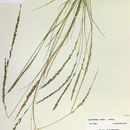Comprehensive Description
provided by North American Flora
Sporobolus indicus (%.) R. Br. Prodr. 170. 1810
Agrostis indica L. Sp. PI. 63. 1753.
Agrostis elongala Lam. Tab. Encyc. 1: 162. 1791. (Type from South America; Agrostis indica L.
cited as synonym.) Not Sporobolus elongatus R. Br. 1810. Vilfa elongata Beauv. Agrost. 16, 147, 181. 1812. (Based on Agrostis elongata Lam.) Sporobolus Lamarckii Desv.; Hamilt. Prodr. 4. 1825. (Based on Agrostis elongata Lam.) Sporobolus Jacquemontii Kunth, Rev. Gram. 427. 1831. (Type from Santo Domingo.) Sporobolus littoralis var. elongatus Dur. & Schinz, Consp. Fl. Afr. 5: 821. 1894. (Based on Vilfa
elongata Beauv.)
Resembling S. Poiretii; blades more slender, especially at base; panicle branches longer, more slender, and less densely flowered, loosely ascending to somewhat spreading, the panicle narrow but not spikelike.
Type locality: Jamaica. The locality given by Linnaeus is "India" but the type specimen was sent from Jamaica by Patrick Browne.
Distribution: Punta Gorda, Florida; ballast, Mobile, Alabama; also tropical America and southeastern Asia.
- bibliographic citation
- Albert Spear Hitchcock. 1937. (POALES); POACEAE (pars). North American flora. vol 17(7). New York Botanical Garden, New York, NY
Physical Description
provided by USDA PLANTS text
Perennials, Terrestrial, not aquatic, Stems nodes swollen or brittle, Stems erect or ascendin g, Stems caespitose, tufted, or clustered, Stems terete, round in cross section, or polygonal, Stem internodes hollow, Stems with inflorescence less than 1 m tall, Stems, culms, or scapes exceeding basal leaves, Leaves mostly cauline, Leaves conspicuously 2-ranked, distichous, Leaves sheathing at base, Leaf sheath mostly open, or loose, Leaf sheath smooth, glabrous, Leaf sheath or blade keeled, Leaf sheath and blade differentiated, Leaf blades linear, Leaf blades 2-10 mm wide, Leaf blades mostly flat, Leaf blade margins folded, involute, or conduplicate, Leaf blades mostly glabrous, Leaf blades more or less hairy, Ligule present, Ligule a fringe of hairs, Inflorescence terminal, Inflorescence a contracted panicle, narrowly paniculate, branches appressed or ascending, Inflorescence solitary, with 1 spike, fascicle, glomerule, head, or cluster per stem or culm, Inflorescence branches more than 10 to numerous, Flowers bisexual, Spikelets pedicellate, Spikelets laterally compr essed, Inflorescence or spikelets partially hidden in leaf sheaths, subtended by spatheole, Spikelet less than 3 mm wide, Spikelets with 1 fertile floret, Spikelets solitary at rachis nodes, Spikelets all alike and fertille, Spikelets bisexual, Spikelets disarticulating above the glumes, glumes persistent, Rachilla or pedicel glabrous, Glumes present, empty bracts, Glumes 2 clearly present, Glumes distinctly unequal, Glumes shorter than adjacent lemma, Glumes 1 nerved, Lemmas thin, chartaceous, hyaline, cartilaginous, or membranous, Lemma similar in texture to glumes, Lemma 1 nerved, Lemma glabrous, Lemma apex acute or acuminate, Lemma awnless, Lemma straight, Palea present, well developed, Palea membranous, hyaline, Palea about equal to lemma, Palea 2 nerved or 2 keeled, Stamens 3, Styles 2-fid, deeply 2-branched, Stigmas 2, Fruit - caryopsis, Caryopsis ellipsoid, longitudinally grooved, hilum long-linear.
Sporobolus indicus: Brief Summary
provided by wikipedia EN
Sporobolus indicus is a species of grass known by the common name smut grass.
- license
- cc-by-sa-3.0
- copyright
- Wikipedia authors and editors

